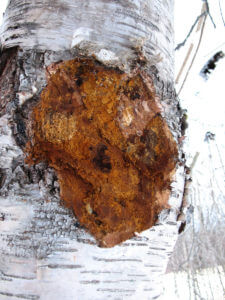Chaga Tea Recipe
First a little background, chaga is a fungus that grows on birch trees, it is often referred to as a “mushroom” (though it isn’t truly classified as one). Chaga chunks look like wood that has been chard on one side. The tea made from chaga tastes very much like regular black tea, but with a little more character. I’m originally from Louisiana, we drank a lot of iced tea and this tastes very good!
Chaga has one of the highest antioxidant (1,104 ORAC units per gram. ORAC stands for “Oxygen Radical Absorbent Capacity”) values of any food, higher than acai, pomegranate, and blueberries. It also has many health benefits. 
- chaga is an “adaptogen” and “immunomodulator” ( or “immunologic adjuvant” to doctors). It improves the immune response without over stimulating it.
- fights several types of cancer
- shown to benefit ulcerative colitis
- helps treat certain parasitic infections
- reduces chronic inflammation
- reduces stomach pain
- helps treat liver disease
Someone could write a book just on the benefits and history of chaga, but you came here to learn how to make it. So here we go.
Directions
- I purchase my chaga chunks on eBay, but you can also find them on Etsy, or even Amazon (though that is the most expensive option). Look around because the price varies quite a bit; make sure you get “chunks”, not powder. Find a seller with good ratings at a good price. The unused chunks last a long time; I’ve read 3 years, un-refrigerated and kept in a cool dry location. But I think I wouldn’t want to push it past 12-18 months myself. The chunks are very dry and feel like light weight wood.
- If your Chaga chunks are bigger than about 3” in any direction, you’ll want to split them. I’ve tried several methods, usually ending up with small pieces flying everywhere. I’ve found the easiest way to do this with a heavy knife and a rubber hammer, they split easily this way. If it seems hard to split in one direction, turn the chunk 90° and try again, there is a slight grain to it, but its hard to see.
- Add about 6-7 ounces of chaga chunks (for a 6 quart pressure cooker) or 8-10 ounces (for the 8 quart) (by weight) into your Instant Pot (or other pressure cooker), fill the instant pot with water up to the fill line. I use purified or spring water, but tap is OK too.
- Pressure cook on high for 12-16 minutes; use 12 minutes for the first batch, 14 minutes for the second, and 16 minutes for the third batch (from the same chunks). Turn off the pressure cooker immediately after it’s done and let it do a natural pressure release.
- Fish out the chunks and filter what is left into 3 – 2 quart mason jars (for the 8 quart model), let sit (with lids on) for 2-3 hours until jars are barely warm, then refrigerate.
- This makes a concentrate that works well with 1 part water, 1 part concentrate. I sweeten with a little stevia or monk fruit powder. Drink over ice.
- The chunks can be used for 3 -4 batches, refrigerate the chunks between use in a large ziplock, or similar. The first 3 batches will be a concentrate, if you want to use them a 4th time the 4th batch will probably not need to be diluted.
I do not purchase ground chaga, nor do I grind it myself, it will stay fresher in chunks. When I purchase chaga the chunks are usually larger than I like to use. Because they look and feel like wood my first thought was to try sawing them, that was a lot of work, then I tried an ax, that too was work and the results weren’t that great (pieces flew everywhere). Then I tried a rubber mallet and a large non-serrated knife… BINGO, that works great. The chaga has grain, when you find it the large chunks split very easily. Use a thick cutting board under it and stand near the counter so more pieces bounce of you and not the floor.
Chaga tea makes a great base for adding liquid and powder supplements. You can heat it in the microwave to have it hot. I usually drink a hot version in the morning, and a cold version once or twice during the day. I often mix in other mushroom powders.
The primary mushroom mix that I use is Sacred 7, it contains Maitake, Lion’s Mane, Cordyceps, Reishi, Shiitake, Turkey Tail, and Chaga Powder. When looking for mushroom powders there are two things you should look for “Made from the fruiting bodies” (or similar wording) and “hot water extracted” (or steam extracted). The goodness in mushrooms (mostly unique polysaccharides) are bound up in the chitin (an insoluble fiber) of the mushroom. A hot water extract releases them so we can utilize them. Mushroom powders can be made from the mycelium (the very fine root system) or the fruiting bodies. Though the mycelium certainly has benefits, it is impossible to separate it from the growing medium (usually brown rice when grown commercially). So you have no way of knowing how much is mushroom and how much is brown rice. Also, most of the research studies are done with the fruiting bodies or their extracts. Sacred 7 is both hot water extracted and made only from the fruiting bodies of the mushrooms (the term “fruiting body” doesn’t really apply to chaga). I use other mushroom powders as well, but a good quality mix is a good start.
If you use cinnamon oil (e.g. while on The Gut Health Protocol) you can mix that into your heated chaga tea. Just add a tbsp of oil (I use MCT oil, but coconut oil or butter are fine) and 1/2 a tsp of larch tree fiber if you have it (this allows the oil to mix with water).
Chaga tea is very easy to make and is quite delicious. Don’t tell my Louisiana family, but I think I like it better than regular iced tea! I’m only half joking when I tell people that I was weaned on iced tea, I think I probably was.
NOTE: If you have been told to avoid high oxalate foods (such as spinach, beets and rhubarb) then you may want to consume chaga in moderation, or perhaps avoid it. There is a single case study (in the medical literature) out of Japan based on a 72 year old woman with liver cancer. She was consuming large amounts of chaga powder daily and developed some kidney issues. There was actually no hard evidence that the kidney issues were caused by chaga. Since chaga is consumed by millions of people around the world this single case study holds very little scientific weight. Otherwise, there are no known issues with daily chaga consumption.
© John Herron / The Gut Health Protocol
http://theguthealthprotocol.com
| These statements have not been evaluated by the Food and Drug Administration. This product is not intended to diagnose, treat, cure, or prevent any disease. |
All images posted by John Herron are either "Copyrighted John Herron", or are copyrighted by someone else and are used under license. So please don’t use them elsewhere, you’ll get in trouble.

 Phage Complete comes with a full 30 day money back guarantee, for U.S. purchases this includes the original shipping charges to you!
Phage Complete comes with a full 30 day money back guarantee, for U.S. purchases this includes the original shipping charges to you!